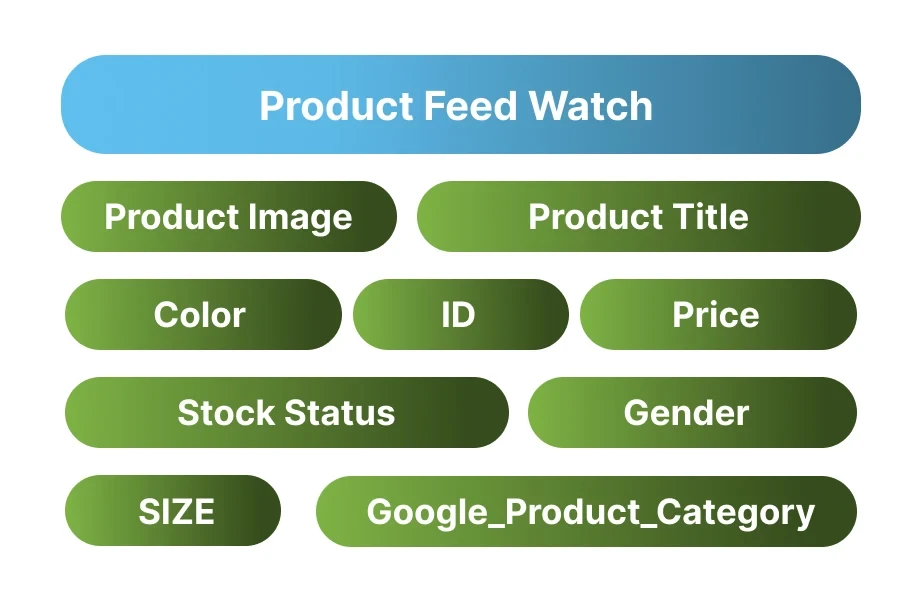Table of Contents
1. Introduction to Product Feeds
2. Key Components of a Product Feed
3. Importance of Product Feeds in eCommerce
4. How to Optimize Your Product Feed
Introduction to Product Feeds
In the fast-paced world of eCommerce, providing accurate and comprehensive product information is essential for success. A product feed, a file containing a detailed list of products along with their attributes, is a critical tool for online retailers. These feeds ensure your products are displayed correctly and consistently across various sales channels like Google, Facebook, and Amazon. By streamlining product information, product feeds help enhance visibility, improve customer trust, and boost the efficiency of your advertising campaigns.

A well-structured product feed can include numerous attributes such as product titles, descriptions, images, prices, availability, and more. These details are vital as they help potential customers make informed purchasing decisions. Moreover, each sales platform may have its own specific requirements for product feeds, making it imperative to optimize them for different channels.
Product feeds not only improve the accuracy of the information presented but also play a pivotal role in inventory management. By keeping your feed updated with real-time data, you can prevent issues like overselling or displaying outdated prices. This synchronization is crucial for maintaining a positive customer experience and avoiding potential pitfalls that can damage your brand’s reputation. Product feeds typically come in common formats such as XML, CSV, TSV, and JSON, which facilitate easy integration and processing by various eCommerce platforms.
What does a product feed look like?
A product feed can contain numerous columns, each holding specific data about the product. These include:

Naturally, images are not directly embedded into your product feed. Instead, you include URLs to the product images, which are processed as text by computers.
Key Components of a Product Feed
A product feed is more than just a list of items; it is a comprehensive database that contains critical information about each product you offer. Understanding the key components of a product feed can help you create a feed that meets the requirements of various eCommerce platforms and maximizes the visibility and appeal of your products.
Product Titles
The product title is often the first piece of information a potential customer sees. It should be clear, concise, and descriptive, including relevant keywords that help with search engine optimization (SEO). For example, instead of “Shirt,” a more effective title might be “Men’s Blue Cotton Shirt – Size L.”
Product Descriptions
Descriptions provide detailed information about the product, including its features, benefits, and usage. A well-written description can differentiate your product from competitors and persuade customers to make a purchase. It should highlight key attributes and answer potential questions a buyer might have.
Product Images
High-quality images are crucial as they give customers a visual representation of the product. Product feeds typically include URLs linking to images rather than the images themselves. Ensure that the images are clear, professional, and accurately depict the product.

Pricing
Accurate pricing information is essential for maintaining trust and transparency with customers. The product feed should include the current price, any discounts, and currency information. This helps avoid confusion and ensures that customers see the correct price when they make a purchase.
Availability
The availability status indicates whether a product is in stock, out of stock, or available for pre-order. Keeping this information up to date helps manage customer expectations and prevents overselling.
Unique Identifiers
Unique identifiers such as SKU (Stock Keeping Unit), GTIN (Global Trade Item Number), or MPN (Manufacturer Part Number) are used to distinguish products. These identifiers help with inventory management and ensure that products are easily searchable across different platforms.
Other Attributes
Depending on the platform and product type, additional attributes might be necessary. These can include size, color, weight, brand, material, and other specific details relevant to the product category. Including as much relevant information as possible enhances the customer’s ability to find and evaluate your products.
By ensuring your product feed contains these key components, you can create a comprehensive and effective feed that meets the requirements of various eCommerce platforms. This not only improves product visibility but also enhances the shopping experience for your customers.
Importance of Product Feeds in eCommerce
Product feeds play a crucial role in the eCommerce ecosystem, acting as the backbone of your online marketing and sales strategies. Here’s why they are so important:
Enhancing Product Visibility and Accuracy
A well-optimized product feed ensures that your products are displayed prominently across multiple sales channels. By providing accurate and up-to-date information, your products are more likely to appear in relevant search results, increasing their visibility to potential customers. This enhanced visibility leads to higher chances of attracting and converting shoppers.
Improving Customer Trust and Experience
Accurate product information is essential for building trust with your customers. When customers find that the product details such as images, descriptions, and prices match what they see on your website, it reinforces their confidence in your brand. Moreover, comprehensive product feeds allow for a seamless shopping experience, as customers can easily find all the information they need to make informed purchasing decisions.

Boosting Advertising Efficiency
Product feeds are integral to running effective advertising campaigns on platforms like Google Shopping, Facebook, and Amazon. These platforms use the data in your product feeds to determine when and where to display your ads. A detailed and well-organized feed ensures that your ads are shown to the right audience, thereby maximizing the return on your advertising spend. Poorly optimized feeds, on the other hand, can result in wasted ad spend and missed sales opportunities.
Streamlining Inventory Management
Keeping your product feed updated with real-time data helps manage your inventory more effectively. This synchronization prevents issues such as overselling or displaying outdated prices, which can lead to customer dissatisfaction and potential loss of sales. By maintaining accurate inventory levels, you can ensure that customers always have access to current product information.
Facilitating Multichannel Selling
With the rise of multichannel retailing, it’s important to have a consistent presence across various sales platforms. Product feeds allow you to manage and distribute your product information seamlessly across different channels. This multichannel approach not only expands your reach but also helps in tapping into diverse customer bases.
Supporting Data-Driven Decisions
Product feeds provide valuable insights into customer behavior and sales performance. By analyzing the data from your feeds, you can identify trends, understand customer preferences, and make informed decisions about pricing, inventory, and marketing strategies. This data-driven approach helps in optimizing your overall eCommerce operations and enhancing your competitive edge.
In summary, product feeds are essential for maximizing the efficiency and effectiveness of your eCommerce efforts. They enhance product visibility, improve customer trust, boost advertising performance, streamline inventory management, facilitate multichannel selling, and support data-driven decision-making. Investing in well-optimized product feeds is a strategic move that can significantly impact your online retail success.
How to Optimise Your Product Feed
Optimizing your product feed is essential to ensure that your products are displayed accurately and attractively across various e-commerce platforms. Here are some best practices to help you get the most out of your product feed:
Optimize Your Product Titles
Product titles are one of the most important elements in your feed. They should be clear, concise, and contain relevant keywords that potential customers might use when searching for your products. Include essential details such as brand, product type, color, size, and any unique features. For example, instead of “Shirt,” use “Men’s Blue Cotton Shirt – Size L.”
Enhance Product Descriptions
A well-crafted product description can significantly impact a customer’s purchasing decision. Make sure your descriptions are detailed, engaging, and highlight the key features and benefits of the product. Use bullet points to make information easily scannable and include relevant keywords to improve search visibility.

Use High-Quality Images
Images are the first thing customers notice about your product listings. Ensure that your images are high-resolution, professionally taken, and accurately represent the product. Include multiple angles and, if possible, show the product in use. Remember, you should provide URLs to these images in your product feed, not the images themselves.
Maintain Accurate Pricing Information
Keep your pricing information up to date to avoid customer frustration and potential loss of sales. Include any promotional prices, discounts, and ensure the currency is correctly specified. Accurate pricing helps build trust and can improve your ad performance.
Ensure Availability Status Is Updated
Regularly update the availability status of your products to reflect current stock levels. Indicating whether a product is in stock, out of stock, or available for pre-order helps manage customer expectations and reduces the risk of overselling.
Include Unique Identifiers
Use unique identifiers such as SKU, GTIN, or MPN for each product. These identifiers help platforms categorize and display your products correctly. They also aid in tracking inventory and sales performance.
Category Mapping
Different eCommerce platforms have their own categorization systems. Ensure that your products are correctly categorized according to each platform’s requirements. Proper category mapping can significantly improve the visibility of your products and make it easier for customers to find them.
Exclude Non-Performing Products
Analyze your sales data to identify products that are not performing well on specific platforms. Consider excluding these products from your feed to focus on items with higher sales potential. This can help optimize your advertising spend and improve overall campaign performance.
Utilize Feed Management Tools
Consider using feed management tools to automate and optimize your product feeds. These tools can help you create, update, and manage your feeds efficiently across multiple platforms. They often come with features like error detection, bulk editing, and performance tracking, making it easier to maintain high-quality feeds.
Regularly Audit and Update Your Feed
Conduct regular audits of your product feed to ensure all information is accurate and up to date. Make adjustments as needed to reflect changes in your product catalog, pricing, or stock levels. Keeping your feed current is essential for maintaining high performance in your advertising campaigns.
By following these optimization practices, you can enhance the quality and effectiveness of your product feed, leading to better visibility, higher customer satisfaction, and improved sales performance.

Conclusion
In the dynamic world of eCommerce, product feeds are indispensable tools that significantly enhance the effectiveness of your online retail strategy. By understanding and optimizing your product feeds, you can ensure that your products are presented accurately and attractively across multiple sales channels. This not only boosts product visibility and customer trust but also improves the efficiency of your advertising campaigns and overall sales performance.
A well-structured product feed includes essential components like product titles, descriptions, images, prices, and availability statuses. By regularly updating and optimizing these elements, you can provide a seamless and satisfying shopping experience for your customers. Additionally, utilizing feed management tools can streamline the process, allowing for easier maintenance and better performance tracking.
Investing time and resources into creating and maintaining optimized product feeds is crucial for any online retailer aiming for success in today’s competitive market. By doing so, you can maximize the impact of your eCommerce efforts, leading to increased customer satisfaction and higher conversion rates.




